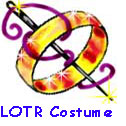

|
|
Patterning in LeatherThe rules for working with and laying a pattern out in leather are different than fabric. There are a few quirks but once you learn these, you'll find it's a great material to work with to get wonderful results. Here we present a selection of tips... More always welcome. As part of the preparation for working on your project... also check out. Laying out LeatherAlways lay out your pattern on leather as if you are using a "with nap" fabric. Leather definitely has a nap. Be very careful to get the grain line perfect. The line should run from head to tail. Leather stretches. -Cat- Pattern ConsiderationsYou may have to break up your pattern into more pieces because of the size of the hides. Remember to add seam allowances at the join. In LOTR the men's surcoats are normally seamed front, back and sides. They have a waist seam an the bottom pieces are separate. Avoid doing a pattern with long pieces that are cut and stitched on the bias. You cannot guarantee how the fabric will stretch. You may get lumps and ripples, not the glamour your planned.. Leather edges do not need to be finished. Remember to remove the seam allowances there. On the other hand, decorative techniques may call for turning the edge under anyway, or binding the edge to strength it. Also you can "pink" the edges. (Pinking is decorate cuts.) Different weights of leather require different handing and types of patterns. The heavier the leather, the more simple the pattern should be. Do a muslin and get the pattern right the first time. If you are using heavy weight leather, make your final "muslin" out of a heaver fabric, stiff denim or even brown paper. The brown paper will work even for heavy leather surcoats. If you are doing an accessory piece like vambrace... brown paper pattern and tape works quite well to work out your pattern. Remember the heavy weight leathers will only bend in one direction unless wet and molded... and may be too stiff to even bend that one direction with out molding. -Cat- Different areas behave differentlyWatch out for how different areas of the hide behave differently! Animal skins don't tend to be two-dimensional while on an animal, but the leather hide comes out that way, so some areas have be stretched and some compressed to get it that way. If you lay the hide out you can get an idea of which end was the neck, which was the butt, etc. Areas over the butt and lower back will stretch the least (and be the most durable), while the neck, belly and forward shoulder areas of the hide may stretch very badly once incorporated into a garment. Sections of the belly may also have very loose fiber and is the least durable portion of a hide. Even if it may be the most economic way to lay out your pattern pieces try to avoid placing pieces that will take a lot of stress (pieces adjacent to armholes, etc.) from these areas as they may stretch badly and unevenly out of shape once the garment is worn, even if it looked great once off the sewing machine. == Adam S. Pattern Pointers with Thick LeatherSomething else to consider with heavier leather is the amount of inside dimension you lose when you curve it around your body. Because the leather has significant thickness, the inside surface is compressed and the outside surface is stretched when it is bent on a curve. On an average-sized breastplate I've found I need to add up to an entire inch in the overall circumference to get the fit to match measurements and the thin bristolboard template. Your mileage may vary, depending on the leather. == Adam S. Quiver PatternsBack quiver plan == Francois
This page was last updated 04/22/08 |
|